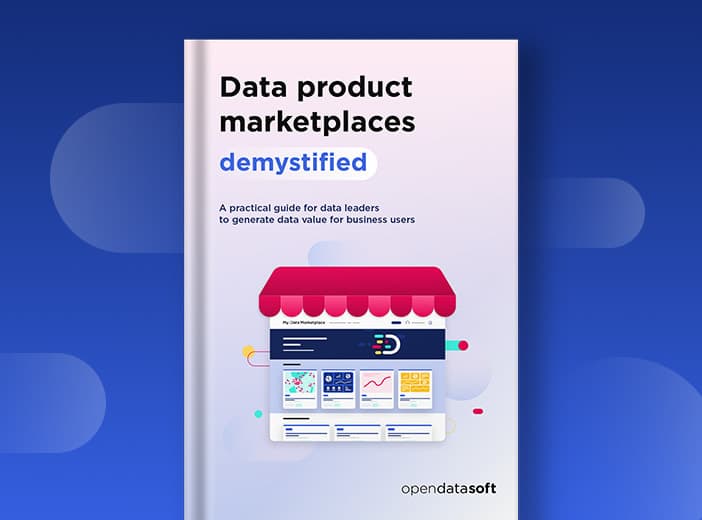What is a data catalog?
Organizations now generate an enormous range of data assets across their operations and departments. Harnessing this data successfully starts with understanding what data is available and where it is located through centralized data catalogs. This blog explains what they are and how they can benefit businesses.

To successfully benefit from their data organizations first need to understand their data landscape. What data assets do they possess, what are their specific attributes, how often are they updated, and who is responsible for managing them?
Organizations therefore have to start their data journey by creating a centralized inventory of all of their data, covering all of their datasets, visualizations and other data assets. This data catalog has to be comprehensive, searchable and easily accessible to all, providing a guide to data and helping drive its reuse. However, given the range, volume, and increasingly complex nature of data assets that organizations own, building a data catalog has to just be the first step in data sharing and making data accessible to all. This blog explores the components and benefits of traditional data catalogs, and how they can be extended and improved through internal data marketplaces.
Why do organizations need a data catalog?
Organizations increasingly rely on data to run their businesses, take better decisions, increase efficiency and improve innovation and collaboration. At the same time the number of different data assets being created and updated across the organization is growing rapidly, due to factors such as digitalization, automation and the rise of the Internet of Things (IoT). Often this data is being generated within specific departments or business units – being able to break down silos and share it across the organization increases its value and creates new uses for these data assets.
However, before they can use it, employees need to know that this data exists and where it is located. This is why many organizations have adopted data catalog solutions. These act like the catalog in a library, which lists all the books it contains, allowing readers to find the location of a specific book, by searching or browsing using terms such as its title, author, publisher or subject.
What features does a data catalog need?
Data catalogs must do two jobs:
- They have to make it easy for users, such as employees, to find the data they need to do their jobs more effectively
- They have to make data management seamless and efficient, by providing data management teams with a complete, up-to-date list of all of their data.
That means that a data catalog needs to have these capabilities:
- It has to be comprehensive, covering all data within the organization
- It has to be easily searchable by both technical and non-technical users. That means it requires accurate metadata to help users discover relevant data assets
- It has to be trustworthy. That means providing sufficient detail on the data (such as its source, owner, and how often it is updated), so that users are confident that it meets their needs
- It has to be self-service, easily available to all relevant users, inside and outside the organization
- It has to be up-to-date, so that it always reflects and includes the latest data
Data catalogs deliver these capabilities through a combination of comprehensive metadata, powerful search functionality, automation to ensure they are continually updated, and by offering a range of tools to help connect users with data.
What are the benefits of a data catalog?
Understanding the data that an organization owns is the first step in being able to use it effectively. A comprehensive data catalog therefore benefits organizations in multiple ways:
- It connects users, inside and outside the business, with the right data, improving efficiency, enabling better-informed decision making and helping build a data-driven culture
- It breaks down silos between departments and organizations, enabling greater collaboration and transparency
- It standardizes data, ensuring it is displayed using consistent terms and formats to make it easy to understand, while removing duplication
- It saves time for data teams as they don’t need to supply individual users with data in response to their queries. Instead, users are able to find the location of the data they need through self-service, boosting efficiency and saving resources
- It helps underpin data governance through a central catalog of all data, increasing control and enabling regulatory compliance
What are the downsides of a data catalog?
It is important to understand that a traditional data catalog is essentially a list of data assets that the organization possesses. Just as a library catalog only tells a reader where a book is located on the shelves, a data catalog does not provide a direct link to the data itself. A user has to then follow the directions given to locate the data if they want to use it.
Data catalogs began as technical tools, used by technical experts to create an inventory of an organization’s data assets. That means that while they may support better data management, they don’t necessarily provide a seamless user experience to non-experts. This holds back adoption by the business as users are not confident when accessing data catalogs, preventing their widespread usage.
Moving beyond traditional data catalogs
As shown above, traditional data catalogs only go so far in opening up data and encouraging its wider use. To maximize value from data, organizations need to go further, directly connecting users to data through internal data marketplaces. These combine powerful data catalog capabilities with:
- An e-commerce style user experience that makes search and discovery simple and intuitive, providing personalized recommendations and enabling users to confidently discover relevant data assets
- Direct, self-service access to data assets, so that users can view, download and reuse data without requiring help from data teams
- Full documentation on the data itself, including its owner and their contact details, existing uses and suggestions for further reuse
- A centralized repository of all data assets, not just raw data, available in a range of formats. Internal data marketplaces provide access to assets such as visualizations and dashboards as well as tabular data, downloadable in common formats and via APIs
- Granular access rights, supporting security and compliance by providing role-based permissions and access to data assets. This prevents unauthorized use of sensitive data, applying corporate data governance frameworks and processes across all data
- The use of artificial intelligence (AI) to improve data discoverability. This includes understanding natural language, misspellings or foreign language queries, to deliver tailored, relevant results, rather than relying on users typing in exact keywords within search and suggesting similar datasets based on search terms.
Essentially, internal data marketplaces transform static, technical data catalogs into an intuitive, usable and comprehensive experience that seamlessly and quickly connects users with the right data. This increases data reuse and drives the creation of an innovative, data-centric culture across the organization.
Looking to implement a data catalog or internal data marketplace in your organization? Get in touch with our experts to arrange a demo of our solution and its capabilities.




